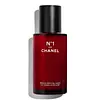What's inside
What's inside
 Key Ingredients
Key Ingredients

 Benefits
Benefits

 Concerns
Concerns

 Ingredients Side-by-side
Ingredients Side-by-side

Camellia Japonica Flower Water
Skin ConditioningPropanediol
SolventGlycerin
HumectantWater
Skin ConditioningPentylene Glycol
Skin ConditioningSodium Citrate
BufferingSodium Polyacrylate
AbsorbentFaex
Skin ConditioningCoffea Arabica Seed Oil
MaskingCamellia Japonica Flower Extract
EmollientParfum
MaskingChlorphenesin
AntimicrobialCitric Acid
BufferingEthylhexyl Palmitate
EmollientCaprylyl Glycol
EmollientXanthan Gum
EmulsifyingSodium Hyaluronate
HumectantChondrus Crispus Powder
AbrasiveAdenosine
Skin ConditioningLactic Acid
BufferingSaccharide Isomerate
Humectant1,2-Hexanediol
Skin ConditioningPalmitoyl Tetrapeptide-7
Skin ConditioningCamellia Japonica Flower Water, Propanediol, Glycerin, Water, Pentylene Glycol, Sodium Citrate, Sodium Polyacrylate, Faex, Coffea Arabica Seed Oil, Camellia Japonica Flower Extract, Parfum, Chlorphenesin, Citric Acid, Ethylhexyl Palmitate, Caprylyl Glycol, Xanthan Gum, Sodium Hyaluronate, Chondrus Crispus Powder, Adenosine, Lactic Acid, Saccharide Isomerate, 1,2-Hexanediol, Palmitoyl Tetrapeptide-7
 Reviews
Reviews

Ingredients Explained
These ingredients are found in both products.
Ingredients higher up in an ingredient list are typically present in a larger amount.
Caprylyl Glycol is a humectant and emollient, meaning it attracts and preserves moisture.
It is a common ingredient in many products, especially those designed to hydrate skin. The primary benefits are retaining moisture, skin softening, and promoting a healthy skin barrier.
Though Caprylyl Glycol is an alcohol derived from fatty acids, it is not the kind that can dry out skin.
This ingredient is also used as a preservative to extend the life of products. It has slight antimicrobial properties.
Learn more about Caprylyl GlycolChlorphenesin is a synthetic preservative. It helps protect a product against bacteria in order to extend shelf life. In most cases, Chlorphenesin is paired with other preservatives such as phenoxyethanol and caprylyl glycol.
Chlorphenesin is a biocide. This means it is able to help fight the microorganisms on our skin. It is also able to fight odor-releasing bacteria.
Chlorphenesin is soluble in both water and glycerin.
Studies show Chlorphenesin is easily absorbed by our skin. You should speak with a skincare professional if you have concerns about using Chlorphenesin.
Learn more about ChlorphenesinParfum is a catch-all term for an ingredient or more that is used to give a scent to products.
Also called "fragrance", this ingredient can be a blend of hundreds of chemicals or plant oils. This means every product with "fragrance" or "parfum" in the ingredients list is a different mixture.
For instance, Habanolide is a proprietary trade name for a specific aroma chemical. When used as a fragrance ingredient in cosmetics, most aroma chemicals fall under the broad labeling category of “FRAGRANCE” or “PARFUM” according to EU and US regulations.
The term 'parfum' or 'fragrance' is not regulated in many countries. In many cases, it is up to the brand to define this term.
For instance, many brands choose to label themselves as "fragrance-free" because they are not using synthetic fragrances. However, their products may still contain ingredients such as essential oils that are considered a fragrance by INCI standards.
One example is Calendula flower extract. Calendula is an essential oil that still imparts a scent or 'fragrance'.
Depending on the blend, the ingredients in the mixture can cause allergies and sensitivities on the skin. Some ingredients that are known EU allergens include linalool and citronellol.
Parfum can also be used to mask or cover an unpleasant scent.
The bottom line is: not all fragrances/parfum/ingredients are created equally. If you are worried about fragrances, we recommend taking a closer look at an ingredient. And of course, we always recommend speaking with a professional.
Learn more about ParfumWater. It's the most common cosmetic ingredient of all. You'll usually see it at the top of ingredient lists, meaning that it makes up the largest part of the product.
So why is it so popular? Water most often acts as a solvent - this means that it helps dissolve other ingredients into the formulation.
You'll also recognize water as that liquid we all need to stay alive. If you see this, drink a glass of water. Stay hydrated!
Learn more about Water